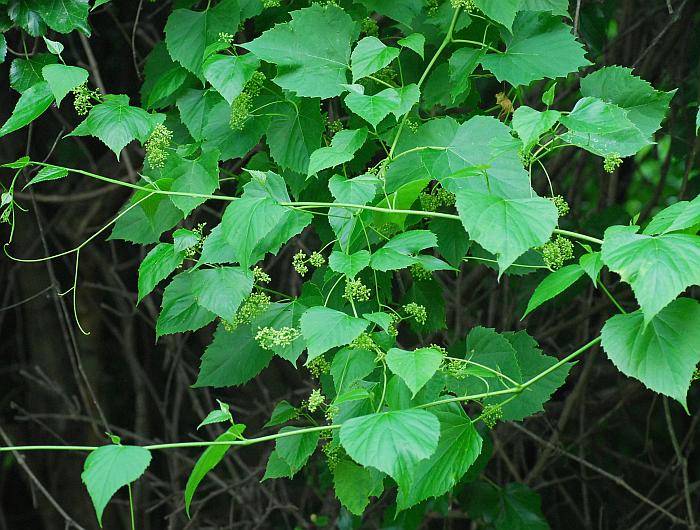Ampelopsis cordata Michx.
Raccoon Grape

Native
CC = 3
CW = 0
MOC = 63
© SRTurner
Ampelopsis cordata Michx.Raccoon Grape | |
 |
Native CC = 3 CW = 0 MOC = 63 |
© SRTurner |
|
Family - Vitaceae Habit - Liana with tendrils, sometimes monoecious. Stems - Climbing, with tight, non shredding bark. Pith continuous through nodes. Tendrils present opposite some, but not all, leaves.
Leaves - Alternate, toothed, unlobed or with two to four small lobes, glabrous, petiolate, truncate to cordate.
Inflorescence - Noticeably broader than long, horizontally branching.
Flowers - Petals 5, free, 2.0-2.8 mm long, persistent and spreading at flowering, greenish yellow. Stamens 5. Nectar disc noticeable under magnification, about half as long as the ovary, cup-shaped, the basal portion fused to the ovary, the rim free, entire or irregularly scalloped. Style often very short, sometimes persistent at fruiting.
Fruits - Globose berries 7-10 mm in diameter, shiny at maturity, changing from green to pink or bluish gray and eventually to bluish or black.
Flowering - May - July. Fruits ripening September - November. Habitat - Wet areas, disturbed sites, low woods, thickets, railroads near woods. Origin - Native to the U.S. Lookalikes - Some species of Vitis. Other info. - This species is common in most areas of Missouri. Its broader range includes most of the lower Midwest, extending southward to the Gulf Coast. In both habit and appearance it is similar to the true grapes (genus Vitis), but can be distinguished by its inflorescences, which are branched and broader than long. True grapes produce elongated clusters of fruits. Photographs taken at the Kansas City Zoo, 6-17-99 and 6-2-00, and along the Elk River, McDonald County, MO., 8-15-03 (DETenaglia); also along Riverfront Park, city of Washington, Franklin County, MO, 6-7-2018 and 7-17-2020, and along the Katy Trail near Dutzow, Warren County, MO, 8-20-2021 (SRTurner). |